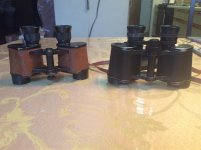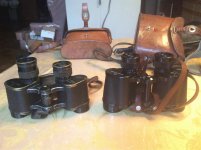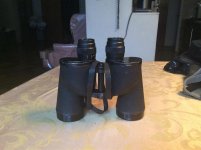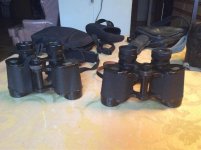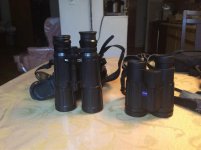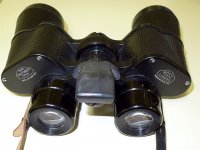Pinewood
New York correspondent

I have been thinking about how binocular manufacturers have addressed the problems eyeglass wearers have using binoculars. I have taken some fairly typical binoculars of the last 97 years as examples of this problem
If everyone had perfect eyesight, there would be no need for a dioptre setting on centre focussing [CF] binoculars. Manufacturers recognized that individuals had different sight in each eye, so dioptre setting was an early feature. If a user’s eyesight was not too far from perfect, the “reach” of the focussing mechanism might allow an eyeglass wearer to use a binocular. However, if one’s eyes were closely matched, there would be a need for only a small about of dioptre accommodation and the user could remove his specs and enjoy the binocular. In individual focussing [IF} binoculars, this was similarly accomplished.
If one had truly bad eyesight, there were three problems. First one might need his eyeglasses to find a target. Most users won’t keep a binocular at his eyes, while moving around. My own methodology is to scan with my eyes seeking something of interest. For those with bad eyesight removing the specs increases the chances of walking into something or tripping. The second problem was adequate focussing “reach” to bring a binocular to focus at infinity. Lastly, there is no accommodation for a user’s astigmatism.
My 1918 Basuch &Lomb 6x30 Signal Corps Model EE, an IF, has enough reach for someone needing a ±7 dioptre accommodation. So does my 1924 Zeiss 6x30 Silvarem, a CF. See photo
If a person had eyesight beyond the focussing accommodation or if he wants to see where he is walking, he needs to wear his glasses. Wearing glasses requires greater eye relief or bringing the eyeglasses closer to the eyepieces. Otherwise he might lose the full field of view. However, some severely myopic users may not experience that loss of FOV.
My 1936 Swiss Armėe Modell 6x24 binocular had collapsing eyecups, allowing an eyeglass wearer to bring his eye closer to the objective, by about 8 mm, and see much more of the field. As the Swiss had universal conscription, I imagine that allowing most soldiers to use a binocular effectively, was a paramount concern. By 1955, the Swiss Army no longer used collapsible eye cups, but the cups are very shallow, on my Swiss Armée Modell 6x30. See photo.
Apparently the U.S. and German military, during WWII, sourced binoculars with less accommodation and standard eyecups, like my Spencer 7x50. See photo. Each probably decided either that soldiers or sailors with inferior eyesight were not going to be looking through binoculars or that such soldiers or sailors could make do with a reduced FOV.
Another method was to sell shallow accessory eyecups which brought the eye closer to the objectives. I have been informed that Bausch & Lomb did just that for their Zephyr line. This allowed an eyeglass wearer to modify the binocular for his own need. Incidentally, I have not been able to find such eye cups, but I did see a B&L clone from Mirakel furnished with such eye cups on that electronic auction site. Leitz/Leica did offer replacement eye cups with a small fold down for their old Porro binoculars but no longer do so. The picture shows two Binuxit 8x30 binoculars: one with the standard eyecups and one with the fold down cups.
My 1918 Basuch &Lomb 6x30 Signal Corps Model EE, an IF, has enough reach for someone needing a ±7 dioptre accommodation. So does my 1924 Zeiss 6x30 Silvarem, a CF. See the first photo
If a person had eyesight beyond the focussing accommodation or if he wants to see where he is walking, he needs to wear his glasses. Wearing glasses requires greater eye relief or bringing the eyeglasses closer to the eyepieces, while maintaining the full Field of View[FOV]. However, some severely myopic users may not experience that loss of FOV.
My 1936 Swiss Armyėe Modell 6x24 binocular had collapsing eyecups, allowing an eyeglass wearer to bring his eye closer to the objective, by about 8 mm, and see the whole field. As the Swiss had universal conscription, I imagine that allowing most soldiers to use a binocular effectively, was a paramount concern. use the binoculars. By 1955, the Swiss Army no longer used collapsible eye cups, but the cups are very shallow, on my Swiss Armée Modell 6x30. See the second photo.
Apparently the U.S. and German military, during WWII, sourced binoculars with less accommodation and standard eyecups, like my Spencer 7x50. Each probably decided that soldiers or sailors with inferior eyesight were not going to
use a binocular or would have to make do with a narrow FOV. See the third photo.
Another method was to sell shallow accessory eyecups which brought the eye closer to the objectives. I have been informed that Bausch & Lomb did just that for their Zephyr line. This allowed an eyeglass wearer to modify the binocular for his own need. Incidentally, I have not been able to find such eye cups, but I did see a B&L clone from Mirakel furnished with such eye cups, pictured on that electronic auction site. Leitz/Leica did offer replacement eye cups with a small fold down for their old Porro binoculars but no longer do so. The fourth photo shows two Binuxit 8x30 binoculars: one with the standard eyecups and one with the fold down cups.
Finally, the manufacturers addressed the problems of having long eye relief. With fold down or collapsible eyecups, a binoculars were available which allowed eyeglass wearers and those who did not need them to use binoculars. As far as I know, Zeiss was the first manufacturer to make such binoculars, almost more than 50 years, ago in their 8x30B. “B” is short for Briller, German for eyeglasses. So a user with astigmatism could get full use of his binoculars. the "B" model had a narrow FOV than the standard 8x30 from the West German Zeiss line.
Every now and then, I want to take off my glasses and look unhindered through a binocular, even with my astigmatism. Most binoculars no longer focus at infinity for those needing large diopter correction, say ±6. I suppose that manufacturers have decided that with long eye relief, those with poor eyesight will be using their specs. A couple of years ago, when my eyesight was a little worse, my Zeiss ClasiC 7x42 BGAT, on the left in the fifth photo, almost allowed me to focus to infinity without my specs, when my eyesight was poorer; nowadays it does focus to infinity for me. My Zeiss FL 8x32 allows me to focus as far as 165 meters, not quite to infinity. See the fifth photo. Its dioptre adjustment is specified at ±4, but I think one can get a little more. See photo. The FL is a very nice optic, managing to have sufficient eye relief, suppression of chromatic aberration, compact size and an FOV of 140m at 1000m, just about 8º. I do not know if that is the best current binocular for eyeglass wearers but it does work nicely.
All photos made with an iPad.
Happy bird watching,
Arthur :scribe:
If everyone had perfect eyesight, there would be no need for a dioptre setting on centre focussing [CF] binoculars. Manufacturers recognized that individuals had different sight in each eye, so dioptre setting was an early feature. If a user’s eyesight was not too far from perfect, the “reach” of the focussing mechanism might allow an eyeglass wearer to use a binocular. However, if one’s eyes were closely matched, there would be a need for only a small about of dioptre accommodation and the user could remove his specs and enjoy the binocular. In individual focussing [IF} binoculars, this was similarly accomplished.
If one had truly bad eyesight, there were three problems. First one might need his eyeglasses to find a target. Most users won’t keep a binocular at his eyes, while moving around. My own methodology is to scan with my eyes seeking something of interest. For those with bad eyesight removing the specs increases the chances of walking into something or tripping. The second problem was adequate focussing “reach” to bring a binocular to focus at infinity. Lastly, there is no accommodation for a user’s astigmatism.
My 1918 Basuch &Lomb 6x30 Signal Corps Model EE, an IF, has enough reach for someone needing a ±7 dioptre accommodation. So does my 1924 Zeiss 6x30 Silvarem, a CF. See photo
If a person had eyesight beyond the focussing accommodation or if he wants to see where he is walking, he needs to wear his glasses. Wearing glasses requires greater eye relief or bringing the eyeglasses closer to the eyepieces. Otherwise he might lose the full field of view. However, some severely myopic users may not experience that loss of FOV.
My 1936 Swiss Armėe Modell 6x24 binocular had collapsing eyecups, allowing an eyeglass wearer to bring his eye closer to the objective, by about 8 mm, and see much more of the field. As the Swiss had universal conscription, I imagine that allowing most soldiers to use a binocular effectively, was a paramount concern. By 1955, the Swiss Army no longer used collapsible eye cups, but the cups are very shallow, on my Swiss Armée Modell 6x30. See photo.
Apparently the U.S. and German military, during WWII, sourced binoculars with less accommodation and standard eyecups, like my Spencer 7x50. See photo. Each probably decided either that soldiers or sailors with inferior eyesight were not going to be looking through binoculars or that such soldiers or sailors could make do with a reduced FOV.
Another method was to sell shallow accessory eyecups which brought the eye closer to the objectives. I have been informed that Bausch & Lomb did just that for their Zephyr line. This allowed an eyeglass wearer to modify the binocular for his own need. Incidentally, I have not been able to find such eye cups, but I did see a B&L clone from Mirakel furnished with such eye cups on that electronic auction site. Leitz/Leica did offer replacement eye cups with a small fold down for their old Porro binoculars but no longer do so. The picture shows two Binuxit 8x30 binoculars: one with the standard eyecups and one with the fold down cups.
My 1918 Basuch &Lomb 6x30 Signal Corps Model EE, an IF, has enough reach for someone needing a ±7 dioptre accommodation. So does my 1924 Zeiss 6x30 Silvarem, a CF. See the first photo
If a person had eyesight beyond the focussing accommodation or if he wants to see where he is walking, he needs to wear his glasses. Wearing glasses requires greater eye relief or bringing the eyeglasses closer to the eyepieces, while maintaining the full Field of View[FOV]. However, some severely myopic users may not experience that loss of FOV.
My 1936 Swiss Armyėe Modell 6x24 binocular had collapsing eyecups, allowing an eyeglass wearer to bring his eye closer to the objective, by about 8 mm, and see the whole field. As the Swiss had universal conscription, I imagine that allowing most soldiers to use a binocular effectively, was a paramount concern. use the binoculars. By 1955, the Swiss Army no longer used collapsible eye cups, but the cups are very shallow, on my Swiss Armée Modell 6x30. See the second photo.
Apparently the U.S. and German military, during WWII, sourced binoculars with less accommodation and standard eyecups, like my Spencer 7x50. Each probably decided that soldiers or sailors with inferior eyesight were not going to
use a binocular or would have to make do with a narrow FOV. See the third photo.
Another method was to sell shallow accessory eyecups which brought the eye closer to the objectives. I have been informed that Bausch & Lomb did just that for their Zephyr line. This allowed an eyeglass wearer to modify the binocular for his own need. Incidentally, I have not been able to find such eye cups, but I did see a B&L clone from Mirakel furnished with such eye cups, pictured on that electronic auction site. Leitz/Leica did offer replacement eye cups with a small fold down for their old Porro binoculars but no longer do so. The fourth photo shows two Binuxit 8x30 binoculars: one with the standard eyecups and one with the fold down cups.
Finally, the manufacturers addressed the problems of having long eye relief. With fold down or collapsible eyecups, a binoculars were available which allowed eyeglass wearers and those who did not need them to use binoculars. As far as I know, Zeiss was the first manufacturer to make such binoculars, almost more than 50 years, ago in their 8x30B. “B” is short for Briller, German for eyeglasses. So a user with astigmatism could get full use of his binoculars. the "B" model had a narrow FOV than the standard 8x30 from the West German Zeiss line.
Every now and then, I want to take off my glasses and look unhindered through a binocular, even with my astigmatism. Most binoculars no longer focus at infinity for those needing large diopter correction, say ±6. I suppose that manufacturers have decided that with long eye relief, those with poor eyesight will be using their specs. A couple of years ago, when my eyesight was a little worse, my Zeiss ClasiC 7x42 BGAT, on the left in the fifth photo, almost allowed me to focus to infinity without my specs, when my eyesight was poorer; nowadays it does focus to infinity for me. My Zeiss FL 8x32 allows me to focus as far as 165 meters, not quite to infinity. See the fifth photo. Its dioptre adjustment is specified at ±4, but I think one can get a little more. See photo. The FL is a very nice optic, managing to have sufficient eye relief, suppression of chromatic aberration, compact size and an FOV of 140m at 1000m, just about 8º. I do not know if that is the best current binocular for eyeglass wearers but it does work nicely.
All photos made with an iPad.
Happy bird watching,
Arthur :scribe:
Attachments
Last edited:




